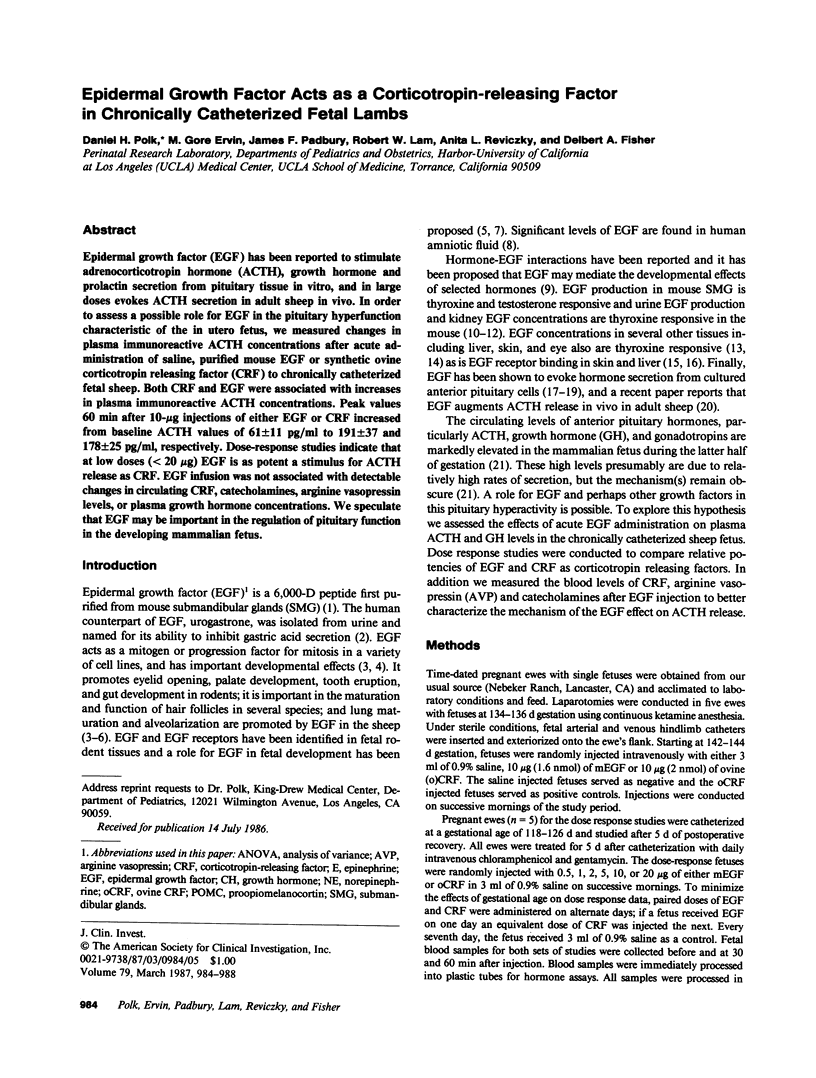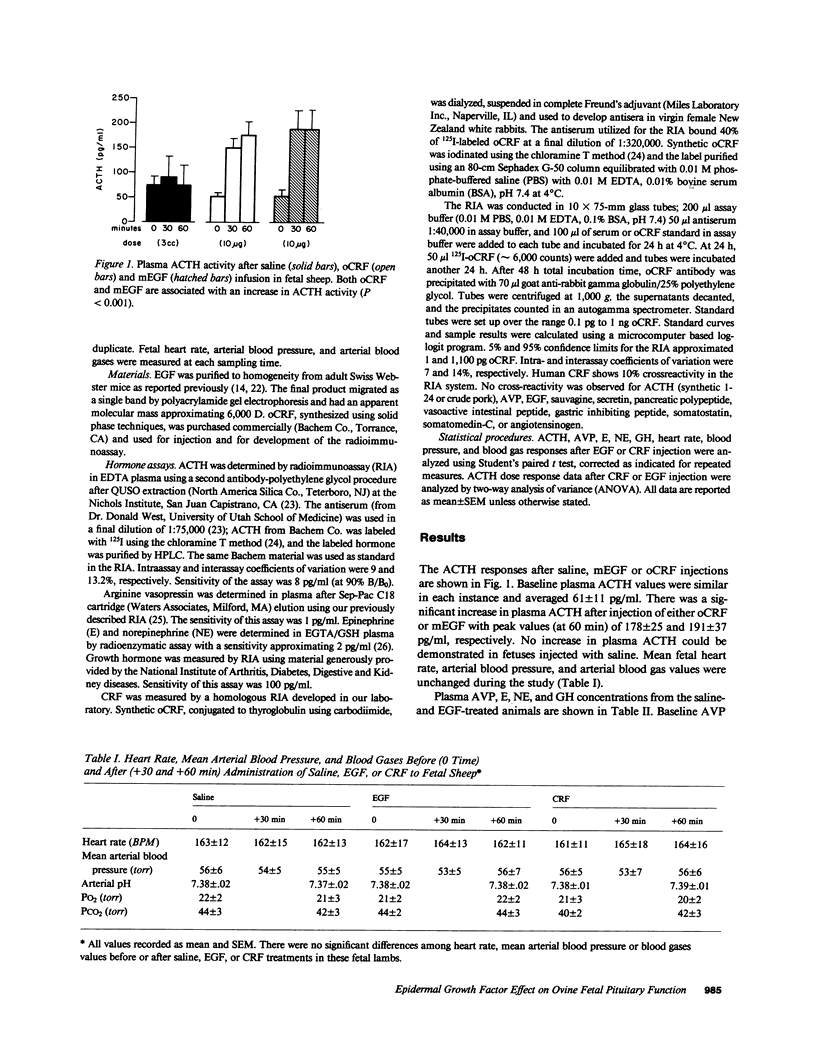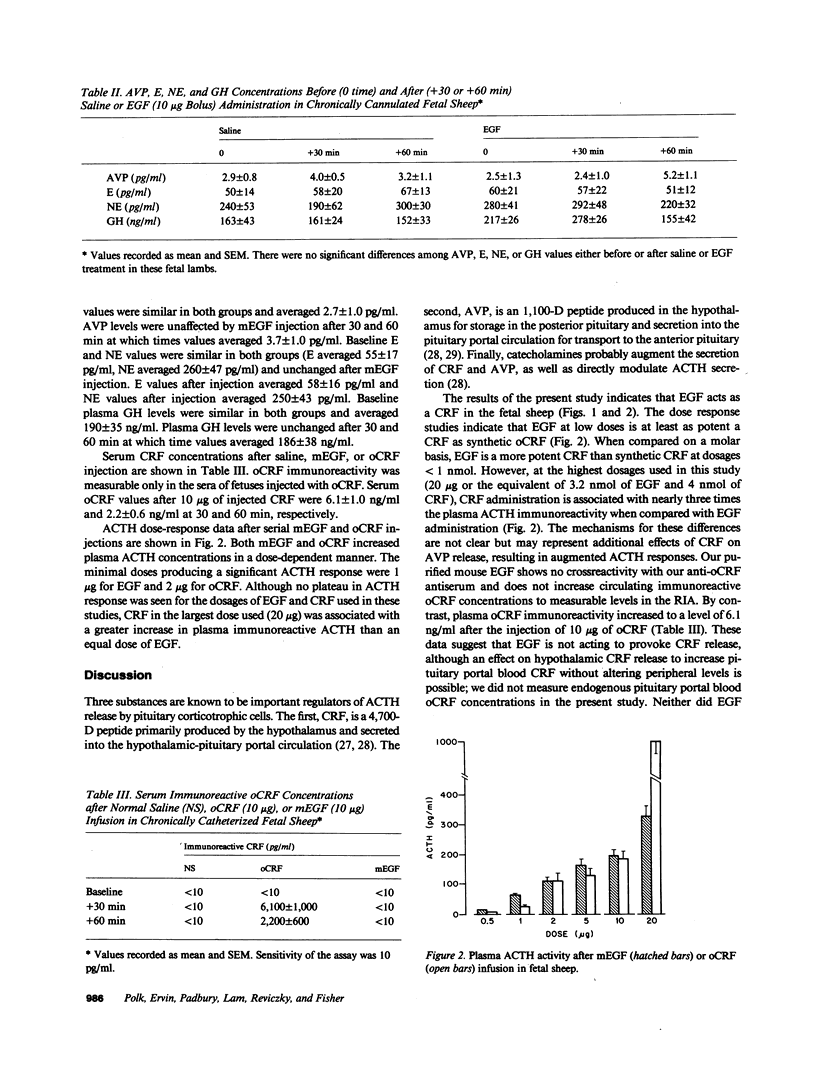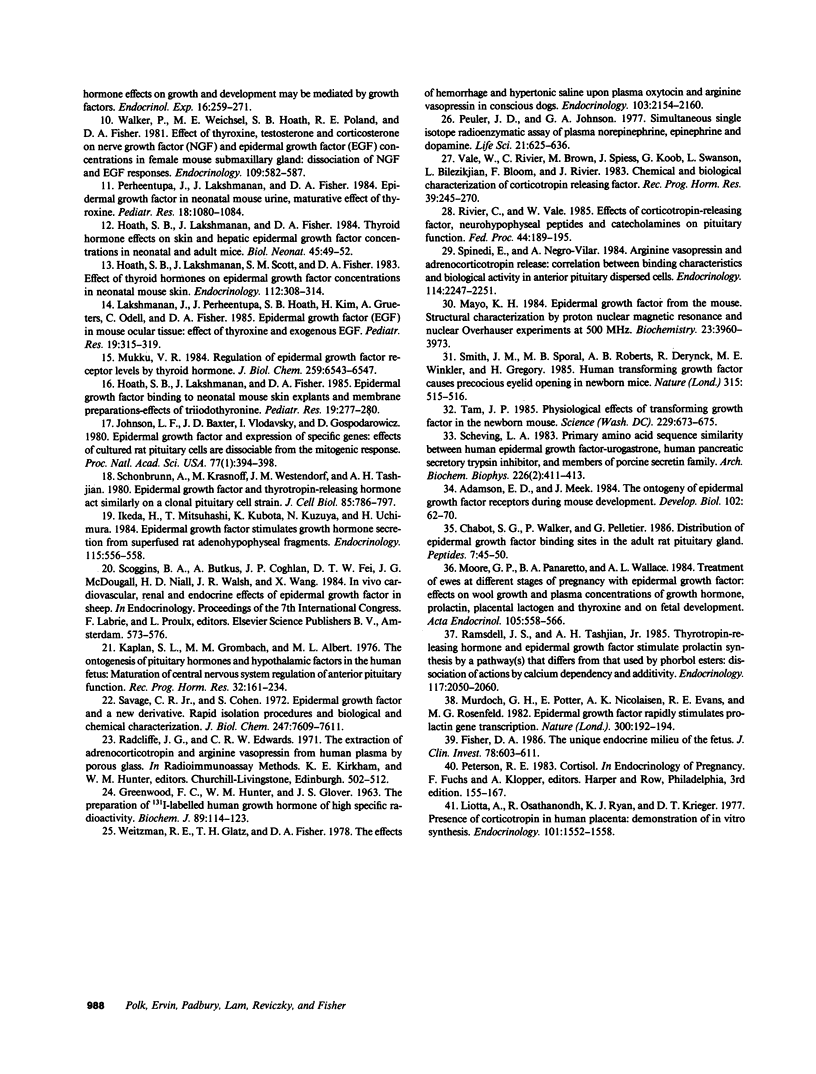Abstract
Epidermal growth factor (EGF) has been reported to stimulate adrenocorticotropin hormone (ACTH), growth hormone and prolactin secretion from pituitary tissue in vitro, and in large doses evokes ACTH secretion in adult sheep in vivo. In order to assess a possible role for EGF in the pituitary hyperfunction characteristic of the in utero fetus, we measured changes in plasma immunoreactive ACTH concentrations after acute administration of saline, purified mouse EGF or synthetic ovine corticotropin releasing factor (CRF) to chronically catheterized fetal sheep. Both CRF and EGF were associated with increases in plasma immunoreactive ACTH concentrations. Peak values 60 min after 10-micrograms injections of either EGF or CRF increased from baseline ACTH values of 61 +/- 11 pg/ml to 191 +/- 37 and 178 +/- 25 pg/ml, respectively. Dose-response studies indicate that at low doses (less than 20 micrograms) EGF is as potent a stimulus for ACTH release as CRF. EGF infusion was not associated with detectable changes in circulating CRF, catecholamines, arginine vasopressin levels, or plasma growth hormone concentrations. We speculate that EGF may be important in the regulation of pituitary function in the developing mammalian fetus.
Full text
PDF




Selected References
These references are in PubMed. This may not be the complete list of references from this article.
- Adamson E. D., Meek J. The ontogeny of epidermal growth factor receptors during mouse development. Dev Biol. 1984 May;103(1):62–70. doi: 10.1016/0012-1606(84)90007-1. [DOI] [PubMed] [Google Scholar]
- Barka T., van der Noen H., Gresik E. W., Kerenyi T. Immunoreactive epidermal growth factor in human amniotic fluid. Mt Sinai J Med. 1978 Nov-Dec;45(6):679–684. [PubMed] [Google Scholar]
- COHEN S. Isolation of a mouse submaxillary gland protein accelerating incisor eruption and eyelid opening in the new-born animal. J Biol Chem. 1962 May;237:1555–1562. [PubMed] [Google Scholar]
- Calvert R., Beaulieu J. F., Ménard D. Epidermal growth factor (EGF) accelerates the maturation of fetal mouse intestinal mucosa in utero. Experientia. 1982 Sep 15;38(9):1096–1097. doi: 10.1007/BF01955387. [DOI] [PubMed] [Google Scholar]
- Carpenter G., Cohen S. Epidermal growth factor. Annu Rev Biochem. 1979;48:193–216. doi: 10.1146/annurev.bi.48.070179.001205. [DOI] [PubMed] [Google Scholar]
- Chabot J. G., Walker P., Pelletier G. Distribution of epidermal growth factor binding sites in the adult rat anterior pituitary gland. Peptides. 1986 Jan-Feb;7(1):45–50. doi: 10.1016/0196-9781(86)90059-8. [DOI] [PubMed] [Google Scholar]
- Fisher D. A., Hoath S., Lakshmanan J. The thyroid hormone effects on growth and development may be mediated by growth factors. Endocrinol Exp. 1982 Nov;16(3-4):259–271. [PubMed] [Google Scholar]
- Fisher D. A. The unique endocrine milieu of the fetus. J Clin Invest. 1986 Sep;78(3):603–611. doi: 10.1172/JCI112616. [DOI] [PMC free article] [PubMed] [Google Scholar]
- GREENWOOD F. C., HUNTER W. M., GLOVER J. S. THE PREPARATION OF I-131-LABELLED HUMAN GROWTH HORMONE OF HIGH SPECIFIC RADIOACTIVITY. Biochem J. 1963 Oct;89:114–123. doi: 10.1042/bj0890114. [DOI] [PMC free article] [PubMed] [Google Scholar]
- Gospodarowicz D. Epidermal and nerve growth factors in mammalian development. Annu Rev Physiol. 1981;43:251–263. doi: 10.1146/annurev.ph.43.030181.001343. [DOI] [PubMed] [Google Scholar]
- Gregory H. Isolation and structure of urogastrone and its relationship to epidermal growth factor. Nature. 1975 Sep 25;257(5524):325–327. doi: 10.1038/257325a0. [DOI] [PubMed] [Google Scholar]
- Hoath S. B., Lakshmanan J., Fisher D. A. Epidermal growth factor binding to neonatal mouse skin explants and membrane preparations--effect of triiodothyronine. Pediatr Res. 1985 Mar;19(3):277–281. doi: 10.1203/00006450-198503000-00004. [DOI] [PubMed] [Google Scholar]
- Hoath S. B., Lakshmanan J., Fisher D. A. Thyroid hormone effects on skin and hepatic epidermal growth factor concentrations in neonatal and adult mice. Biol Neonate. 1984;45(1):49–52. doi: 10.1159/000241762. [DOI] [PubMed] [Google Scholar]
- Hoath S. B., Lakshmanan J., Scott S. M., Fisher D. A. Effect of thyroid hormones on epidermal growth factor concentration in neonatal mouse skin. Endocrinology. 1983 Jan;112(1):308–314. doi: 10.1210/endo-112-1-308. [DOI] [PubMed] [Google Scholar]
- Hollenberg M. D. Epidermal growth factor-urogastrone, a polypeptide acquiring hormonal status. Vitam Horm. 1979;37:69–110. doi: 10.1016/s0083-6729(08)61068-7. [DOI] [PubMed] [Google Scholar]
- Ikeda H., Mitsuhashi T., Kubota K., Kuzuya N., Uchimura H. Epidermal growth factor stimulates growth hormone secretion from superfused rat adenohypophyseal fragments. Endocrinology. 1984 Aug;115(2):556–558. doi: 10.1210/endo-115-2-556. [DOI] [PubMed] [Google Scholar]
- Johnson L. K., Baxter J. D., Vlodavsky I., Gospodarowicz D. Epidermal growth factor and expression of specific genes: effects on cultured rat pituitary cells are dissociable from the mitogenic response. Proc Natl Acad Sci U S A. 1980 Jan;77(1):394–398. doi: 10.1073/pnas.77.1.394. [DOI] [PMC free article] [PubMed] [Google Scholar]
- Kaplan S. L., Grumbach M. M., Aubert M. L. The ontogenesis of pituitary hormones and hypothalamic factors in the human fetus: maturation of central nervous system regulation of anterior pituitary function. Recent Prog Horm Res. 1976;32:161–243. doi: 10.1016/b978-0-12-571132-6.50015-4. [DOI] [PubMed] [Google Scholar]
- Lakshmanan J., Perheentupa J., Hoath S. B., Kim H., Gruters A., Odell C., Fisher D. A. Epidermal growth factor in mouse ocular tissue: effects of thyroxine and exogenous epidermal growth factor. Pediatr Res. 1985 Mar;19(3):315–319. doi: 10.1203/00006450-198503000-00013. [DOI] [PubMed] [Google Scholar]
- Liotta A., Osathanondh R., Ryan K. J., Krieger D. T. Presence of corticotropin in human placenta: demonstration of in vitro synthesis. Endocrinology. 1977 Nov;101(5):1552–1558. doi: 10.1210/endo-101-5-1552. [DOI] [PubMed] [Google Scholar]
- Mayo K. H. Epidermal growth factor from the mouse. Structural characterization by proton nuclear magnetic resonance and nuclear overhauser experiments at 500 MHz. Biochemistry. 1984 Aug 14;23(17):3960–3973. doi: 10.1021/bi00312a025. [DOI] [PubMed] [Google Scholar]
- Moore G. P., Panaretto B. A., Wallace A. L. Treatment of ewes at different stages of pregnancy with epidermal growth factor: effects on wool growth and plasma concentrations of growth hormone, prolactin, placental lactogen and thyroxine and on foetal development. Acta Endocrinol (Copenh) 1984 Apr;105(4):558–566. doi: 10.1530/acta.0.1050558. [DOI] [PubMed] [Google Scholar]
- Mukku V. R. Regulation of epidermal growth factor receptor levels by thyroid hormone. J Biol Chem. 1984 May 25;259(10):6543–6547. [PubMed] [Google Scholar]
- Murdoch G. H., Potter E., Nicolaisen A. K., Evans R. M., Rosenfeld M. G. Epidermal growth factor rapidly stimulates prolactin gene transcription. Nature. 1982 Nov 11;300(5888):192–194. doi: 10.1038/300192a0. [DOI] [PubMed] [Google Scholar]
- Nexø E., Hollenberg M. D., Figueroa A., Pratt R. M. Detection of epidermal growth factor-urogastrone and its receptor during fetal mouse development. Proc Natl Acad Sci U S A. 1980 May;77(5):2782–2785. doi: 10.1073/pnas.77.5.2782. [DOI] [PMC free article] [PubMed] [Google Scholar]
- Perheentupa J., Lakshmanan J., Fisher D. A. Epidermal growth factor in neonatal mouse urine: maturative effect of thyroxine. Pediatr Res. 1984 Nov;18(11):1080–1084. doi: 10.1203/00006450-198411000-00004. [DOI] [PubMed] [Google Scholar]
- Peuler J. D., Johnson G. A. Simultaneous single isotope radioenzymatic assay of plasma norepinephrine, epinephrine and dopamine. Life Sci. 1977 Sep 1;21(5):625–636. doi: 10.1016/0024-3205(77)90070-4. [DOI] [PubMed] [Google Scholar]
- Ramsdell J. S., Tashjian A. H., Jr Thyrotropin-releasing hormone and epidermal growth factor stimulate prolactin synthesis by a pathway(s) that differs from that used by phorbol esters: dissociation of actions by calcium dependency and additivity. Endocrinology. 1985 Nov;117(5):2050–2060. doi: 10.1210/endo-117-5-2050. [DOI] [PubMed] [Google Scholar]
- Rivier C., Vale W. Effects of corticotropin-releasing factor, neurohypophyseal peptides, and catecholamines on pituitary function. Fed Proc. 1985 Jan;44(1 Pt 2):189–195. [PubMed] [Google Scholar]
- Savage C. R., Jr, Cohen S. Epidermal growth factor and a new derivative. Rapid isolation procedures and biological and chemical characterization. J Biol Chem. 1972 Dec 10;247(23):7609–7611. [PubMed] [Google Scholar]
- Scheving L. A. Primary amino acid sequence similarity between human epidermal growth factor-urogastrone, human pancreatic secretory trypsin inhibitor, and members of porcine secretin family. Arch Biochem Biophys. 1983 Oct 15;226(2):411–413. doi: 10.1016/0003-9861(83)90309-0. [DOI] [PubMed] [Google Scholar]
- Schonbrunn A., Krasnoff M., Westendorf J. M., Tashjian A. H., Jr Epidermal growth factor and thyrotropin-releasing hormone act similarly on a clonal pituitary cell strain. Modulation of hormone production and inhbition of cell proliferation. J Cell Biol. 1980 Jun;85(3):786–797. doi: 10.1083/jcb.85.3.786. [DOI] [PMC free article] [PubMed] [Google Scholar]
- Smith J. M., Sporn M. B., Roberts A. B., Derynck R., Winkler M. E., Gregory H. Human transforming growth factor-alpha causes precocious eyelid opening in newborn mice. Nature. 1985 Jun 6;315(6019):515–516. doi: 10.1038/315515a0. [DOI] [PubMed] [Google Scholar]
- Spinedi E., Negro-Vilar A. Arginine vasopressin and adrenocorticotropin release: correlation between binding characteristics and biological activity in anterior pituitary dispersed cells. Endocrinology. 1984 Jun;114(6):2247–2251. doi: 10.1210/endo-114-6-2247. [DOI] [PubMed] [Google Scholar]
- Tam J. P. Physiological effects of transforming growth factor in the newborn mouse. Science. 1985 Aug 16;229(4714):673–675. doi: 10.1126/science.3860952. [DOI] [PubMed] [Google Scholar]
- Vale W., Rivier C., Brown M. R., Spiess J., Koob G., Swanson L., Bilezikjian L., Bloom F., Rivier J. Chemical and biological characterization of corticotropin releasing factor. Recent Prog Horm Res. 1983;39:245–270. doi: 10.1016/b978-0-12-571139-5.50010-0. [DOI] [PubMed] [Google Scholar]
- Walker P., Weichsel M. E., Jr, Hoath S. B., Poland R. E., Fisher D. A. Effect of thyroxine, testosterone, and corticosterone on nerve growth factor (NGF) and epidermal growth factor (EGF) concentrations in adult female mouse submaxillary gland: dissociation of NGF and EGF responses. Endocrinology. 1981 Aug;109(2):582–587. doi: 10.1210/endo-109-2-582. [DOI] [PubMed] [Google Scholar]
- Weitzman R. E., Glatz T. H., Fisher D. A. The effect of hemorrhage and hypertonic saline upon plasma oxytocin and arginine vasopressin in conscious dogs. Endocrinology. 1978 Dec;103(6):2154–2160. doi: 10.1210/endo-103-6-2154. [DOI] [PubMed] [Google Scholar]


